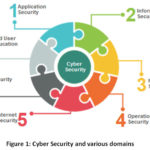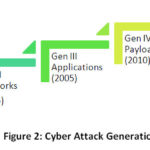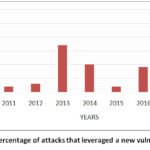Introduction
Due to the
increasing trust and usage of the Internet, almost all the industries,
government and even financial institutions has transformed their transactions
to the cyber infrastructure. This makes the cyber system more vulnerable to
cyberattacks. A cyberattack is a malicious attempt made by an individual or
organization to breach the information system of another individual or
organization. Most commonly, cyberattacks target the business organization,
military, government, or other financial institutions such as banking either
for hacking secured information or for a ransom.
The volume and knowledge of the technology in a cyber attack are increasing drastically. This becomes an important threat to the cyber world. According to Trustwave’s 2015 Global Security Report, approximately, 98% of tested web applications were found vulnerable to cyber-attack. Based on the Department of Business, Innovation and Skills’ 2015 security survey 90% of the huge organization and 74% of the small organization agonized from security breaches.1 Thus the term cybersecurity has become the most prominent field under research. Cybersecurity ensures preserving confidentiality, integrity and availability of information in the Cyberspace.2 Though cybersecurity is a single term, to guarantee the security it involves the coordination of the various other domains. This relationship between various domain is depicted in Figure 1.
These
domains are simply described below.
● Application security implementing various measures to
improve the security of an application. This is often done by monitoring the
application and finding, fixing and preventing security vulnerabilities.
● Information Security is a set of procedures or practices
to maintain the confidentiality, integrity and availability of business data
and information in various forms.
● Network security is a process designed to shield the
usability and integrity of the network and its data and provide secured access
towards the network. Network security always includes both hardware and
software technologies.
● Operations security is a process of identifying and
protecting unclassified critical information which are often attractive for the
competitor or adversary to gain real information.
● Internet security involves various security processes
implemented for ensuring the security of online transactions. It involves
protecting browsers, network, operating systems, and other applications from
attacks by setting up precise rules and regulations.
● ICT security is the ability to protect the
Confidentiality, Integrity and Availability of an organization’s digital
information assets.
● End-User Knowledgeis most significant since people are
the weakest link in the cybersecurity chain. The lack of user knowledge about
cybersecurity risks is the reason for 50% of the cyberattack and almost 90% of
cyberattacks are caused by human behaviour.
However,
the attacks made by the cyber criminals are getting smarter and they use new
methods and technology for successful attacks. They often find the security
holes and breaches in the secured system and steal information or damage the
system in less time.3 In this digital era, since people do all the
major day to day activities online, there is an urgent need for the improved
cyber security with new techniques. To neutralize the cyberattacks, equal
growth in the cyber security as attacks is required. Though several new
techniques are suggested by various researchers and many techniques are
currently in use, the effect of an attack is still increasing.4 Cybersecurity
has to protect any private, personal or government data from attacks by
focusing on three main tasks.5
- Taking
measures to protect equipment, software and the information they contain.
- Guaranteeing
the state or quality of being protected from the several threats; and
- Implementing
and improving these activities.
In recent
years, many non-profit organizations and projects have been carried out with
the aim of facing security threats. The most popular organization is Open Web
Application Security Project (OWASP), an international non-for-profit
charitable organization that focuses on the application security.6
Every year they identify and release the series of software vulnerabilities and
describe the ten most important in their top ten project. In the year of 2018,
the top ten vulnerabilities listed by the OWASP are injection, broken
authentication and session management, sensitive data exposure, XML External
Entities (XXE), Broken Access control, Security misconfigurations, Cross Site
Scripting (XSS), Insecure Deserialization, Using Components with known
vulnerabilities, Insufficient logging and monitoring.7
The cyber-attacks have emerged to the fifth generation, though, 97%. Of organizations are using outdated security technologies and equipped for second and third generation attacks.8 The cybersecurity generations are elaborated in Figure 2.
Cyber Attack Statistics
The number of unique cyber incidents in the second quarter of 2018, as defined by Positive Technologies, was 47 per cent higher than the number from just a year previous. In the third quarter of 2018, Kaspersky Labs the number of malicious mobile installation packages was up by nearly a third when compared to just the previous few months. But there’s an easy way to avoid those attacks, as Norton says that 99.9 per cent of those packages come from unofficial “third party” app stores. The major cyber attacks for the year 2017 is represented as a timeline.
According to the report given by Atlanta Journal-Constitution newspaper – www.ajc.com, $2.7 million spent by the City of Atlanta to repair damage from a ransomware attack. A report was given by 2018 IT Professionals Security Report Survey says that 76% of organizations experienced a phishing attack in the past year and 49% of organizations experienced a DDoS attack in the past year. The ‘Adult Swine’ malware was installed up to 7 million times across 60 Children’s Games Apps. Over 20% of organizations are impacted by Cryptojacking Malware every week and 40% of organizations were impacted by Cryptominers in 2018. (Check Point Research Blog).
Over 300
apps in the google play store contained malware and were downloaded by over 106
million users.9 614 GB of data related to weapons, sensor and
communication systems stolen from US Navy contractor, allegedly by Chinese
government hackers. Check Point global attack sensors undergone a survey on the
new vulnerabilities introduced in the past 8 years The values are depicted in
Figure 3.10
Cyber Security Threats
The common goal of the cyber attacks is to disable or to gain access to the target system. The goal can be achieved by applying various attacks on the target system. Several cyberattacks exist and even evolve day by day. Some of the common cyber attacks are explained below:
Malware: Malware is a malicious software that is designed to cause destruction to a single system or a network. Basic malevolent software such as worms, viruses, and trojans and recent malicious software such as spyware, ransomware belongs to this category. The malware infects the system or network when a user clicks a dangerous link, through an email attachment or while installing risky software. The main point to be noted is that the malware reproduces or spreads when it interacts with other system or device. Some of the causes include blocking access to the network, installs additional spiteful software, gathers information.
Phishing: Phishing is the practice of sending
fraudulent communications that appear to come from a reputable source, usually
through email. The goal is to steal sensitive data like credit card and login
information or to install malware on the victim’s machine. Phishing is an
increasingly common cyber threat.
Man-in-the-middle
attack:
Man-in-the-middle (MitM) attacks occur when attackers insert themselves into a
two-party transaction. Once the attackers interrupt the traffic, they can
filter and steal data. It is normally known as eavesdropping attacks. Several
variations of the MITM attack exists that includes password stealing,
credential forwarding etc. Normally on an unsecure public Wi-Fi, attackers can
insert themselves between a visitor’s device and the network. Without knowing,
the visitor passes all information through the attacker. In some cases, the
attacker installs some software to gather the information about the victim
through malware.
Cryptojacking : A specialized attack that involves
getting someone else’s computer to do the work of generating cryptocurrency for
the target. The attackers will either install malware on the victim’s computer
to perform the necessary calculations, or sometimes run the code in JavaScript
that executes in the victim’s browser.
Denial-of-service
attack: A
denial-of-service attack floods systems, servers, or networks with traffic to
exhaust resources and bandwidth. As a result, the system is unable to process
the legitimate requests. Attackers can also use multiple compromised devices to
launch this attack. Instead of launching single attacks, the attacker launches
several attacks to the victim. This is known as a distributed-denial-of-service
(DDoS) attack. 24% of companies have experienced a DDoS attack in the past year11
SQL Injection: A Structured Query Language (SQL)
injection is a quite common attack that occurs when an attacker inserts
malicious code into a server that uses SQL and forces the server to reveal
information it normally would not. An attacker could carry out a SQL injection
simply by submitting malicious code into a vulnerable website search box.
Zero-day exploit: A zero-day exploit hits after a
network vulnerability is announced but before a patch or solution is
implemented. Attackers target the disclosed vulnerability during this window of
time. Zero-day vulnerability threat detection requires constant awareness.
Spam: it an e-mail message that is
unwanted.12 Spam e-mails can be not only a time-consuming task for
recipients but a source of Java applets that may execute automatically when the
message is read.13
Apart from
the above mentioned threats, SANS Institute identifies the following malicious
spyware actions as the most frequent, malicious activities14:
● changing network settings,
● disabling antivirus and antispyware tools,
● turning off the Microsoft Security Center and/or automatic updates,
● installing rogue certificates,
● cascading file droppers,
● keystroke logging,
● URL monitoring, form scraping and screen scraping,
● turning on the microphone and/or camera,
● pretending to be an antispyware or antivirus tool,
● editing search results,
● acting as a spam relay,
● planting a rootkit or altering the system to prevent removal,
● installing a bot for attacker remote control,
● intercepting sensitive documents and exfiltrating them, or encrypting
them for ransom, planting a
sniffer.
Some of the
fifth generation cyber-attacks includes Andromeda, AdvisorsBot, Cerber, CNRig,
Cryptoloot, Fireball, HiddenMiner, Iotroop, Nivdort, NotPetya, RubyMiner,
Trickbot, WannaCry, WannaMine, Ransomeware, adultSwine, and cryptocurrency
attacks. These are sophisticated attacks that cause severe damage.
Machine Learning and Cybersecurity
Numerous
methods and procedures have been developed in the literature for the detection
of threats in the cyberspace. Recently machine learning has contributed much in
the cyber security. In case of spam detection, basically filters are used to
analyse the content to differentiate whether the message is spam or not. The
machine learning algorithms such as Bayesian classifier,15 SVM,16
MapReduce,17 Behaviour-based spam detection using neural networks,18
Text detection method for image spam filtering19 were suggested.
Statistical
analysis based malware detection was introduced in.20 Marlware
detection using machine learning was suggested.21 Statistical and
dynamical based malware detection was suggested by Shijo and Salim.22
detecting of internet worm malcodes using principal component analysis and
multiclass support vector machine was introduced.23 For detecting
phishing email, random forest machine learning technique was employed.24
Several supervised learning algorithms were introduced to detect the phishing
sites.25 Thus clustering algorithm and classification algorithms
such as SVM, Random Forest, Naïve Bayes classifier, neural network, fuzzy based
classifier is commonly used in detecting the security threats that includes
spam detection, malware detection and phishing detection.
Moving to Fifth Generation Cyber Security
Architecture
The rapid
digital transformation of business places increasing demands on security.
Current security architectures to manage all this are outdated and are the most
common cause for unavailability and security issues that lead to failure. Thus
there is a need for implementing fifth generation architecture that includes
cloud infrastructure and Internet of Things, though, businesses can eliminate
single points of failure by providing the necessary strength and resiliency to
maintain operations and security under any circumstances.
This
security architecture must build a consolidated, unified security architecture
that manages and integrates with mobile, cloud and networks to protect against
and prevent fifth generation cyberattacks. Integrated threat prevention also
needs to work with a dynamic security policy across all platforms that
expresses business needs, supports cloud demands with auto scaling and is able
to flexibly integrate with third-party APIs. Furthermore, a unified and
advanced multi-layered threat prevention environment must include CPU-Level
sandbox prevention, threat extraction, anti-phishing and anti-ransomware
solutions to defend against known and unknown ‘zero-day’ attacks. In this way,
having the right architecture upon which the entire security infrastructure
operates is the only way to ensure a single, cohesive wall of protection to
prevent fifth generation cyberattacks.26
Conclusion
In the past
20 years, cyberattacks and the cybersecurity have advanced and evolved rapidly
due to the technological advancement. Though this is the case, unfortunately,
most organizations have not evolved and are still using second or third
generation cyber security even after the evolution of the fifth generation of
These fifth generation attacks are named as mega attacks as it large-scale and
fast-moving attacks. These sophisticated attacks can effortlessly bypass the
conventional, static detection-based security systems that are used by the most
of the today’s organizations. Thus to defend the latest attacks, organizations
should implement the fifth generation security architecture to protect their
network infrastructure, cloud and mobile infrastructure. Thus to conclude, the
awareness among the organizations and individuals about the cyberattacks and
their effect along with the security solutions are to be increased. Everyone
should use the technology only after analysing the pros and cons and the security
breaches and care must be taken to secure their information. The future work
aims at proposing the fifth generation security framework to protect the online
digital infrastructure that includes cloud, mobile and network infrastructure.
Acknowledgements
This
research has not received any specific grant from funding agencies in the
public, commercial, or not-for-profit sectors. The authors declare no conflict
of interest.
Reference
- Trustwave Global Security. Report retrieved from https://www2.trustwave.com/rs/815-RFM693/images/2015_TrustwaveGlobalSecurityReport.pdf
- International Organization for Standardization. ISO/IEC 27032:2012. Information technology—Security techniques— Guidelines for cybersecurity. 2012
- Chowdhury A. Recent cybersecurity attacks and their mitigation approaches–An Overview. In International conference on applications and techniques in information security, Springer, Singapore. 2016; pp 54-65.
CrossRef - Passeri P. Cyber Attacks Statistics Paolo Passeri, May 2016. http://www.hackmageddon.com/category/security/cyber-attacks-statistics/. Accessed 07 October 2016
- Fischer EA. Creating a national framework for cybersecurity: an analysis of issues and options. Technical report. Congressional Research Service. 2005.
- The Open Web Application Security Project (OWASP). 2018. Available online: https://www.swasc an.com/owasp /
- The Open Web Application Security Project OWASP Top 10—the ten most critical web application security risks. The OWASP Foundation. 2018.
- Check Point Research Survey of IT Security Professionals, sample size: 443 participants. 2018.
- Check Point Mobile Threat Research Publications. 2017. Available Online: https://research.checkpoint.com/check-point-mobile-research-team-looks-back-2017/
- Cyber Attack Trends Analysis Key Insights to Gear Up for in 2019. Available Online: http://www.snt.hr/boxcontent/CheckPointSecurityReport2019_vol01.pdf
- Check Point C-Level Perspective Survey. 2017. sample size: 59 C-Level Executives. Available Online: https://www.checkpoint.com/downloads/product-related/report/2018-security-report.pdf
- Drucker H. Wu D. Vapnik VN. Support vector machines for spam categorization. IEEE Trans Neural Netw Publ IEEE Neural Netw Counc 1999; 10(5):1048–54
CrossRef - Cranor LF. Lamacchia BA. Spam!.Commun ACM. 1998; 41(8):74–83
CrossRef - SANS Institute. Top 15 Malicious Spyware Actions. 2018. Available Online: https://www.sans.org/secur ity-resources/
- Wang Z.J., Liu Y., Wang Z.J. E-mail filtration and classification based on variable weights of the Bayesian algorithm. Appl Mech Mater. 2014; 513–517:2111–2114.
CrossRef - Hsu W.C., Yu T.Y. E-mail spam filtering based on support vector machines with Taguchi method for parameter selection. J Converg Inf Technol 2010. 5(8):78–88.
CrossRef - Caruana G., Li M., Qi M. A MapReduce based parallel SVM for large scale spam filtering. In: IEEE 2011 eighth international conference on fuzzy systems and knowledge discovery (FSKD), 2011; pp 2659–2662.
CrossRef - Wu C.H. Behavior-based spam detection using a hybrid method of rule-based techniques and neural networks. Expert Syst Appl. 2009: 36(3):4321–4330.
CrossRef - Hazza Z.M., Aziz N.A. A new efficient text detection method for image spam filtering. Int Rev ComputSoftw. 2015; 10(1):1–8.
CrossRef - Dhaya R., Poongodi M. Detecting software vulnerabilities in android using static analysis. 2015; pp 915–918.
CrossRef - Markel Z., Bilzor M. Building a machine learning classifier for malware detection. In: Second workshop on anti-malware testing research (WATeR). IEEE. Canterbury. UK. 2015.
CrossRef - Shijo P.V., Salim A. Integrated static and dynamic analysis for malware detection. Procedia Comput Sci. 2015; 46:804–811.
CrossRef - Divya S., Padmavathi G. A novel method for detection of internet worm malcodes using principal component analysis and multiclass support vector machine. Int J Secur Appl. 2014; 8(5):391–402
CrossRef - Akinyelu A.A., Adewumi A.O. Classification of phishing email using random forest machine learning technique. J Appl Math 2014; pp 1–6.
CrossRef - Santhana Lakshmi V., Vijaya M.S. Efficient prediction of phishing websites using supervised learning algorithms. Procedia Eng. 2012; 30:798–805.
CrossRef - Checkpoint 2018 security report. 2018. Available Online: https://www.checkpoint.com/downloads/product-related/report/2018-security-report.pdf.

This work is licensed under a Creative Commons Attribution 4.0 International License.
 , S. Sathya Bama2
, S. Sathya Bama2


